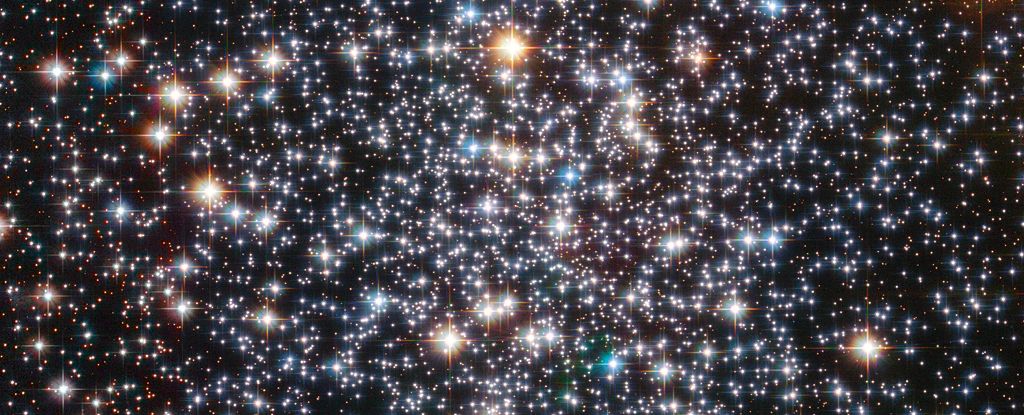
At the heart of a glob of stars drifting through the Milky Way lurks a beast.
Located some 6,000 light-years away, a globular cluster known as Messier 4 appears to be clumped around a black hole some 800 times the mass of our Sun.
That's no featherweight, but it's far from a colossus either. In fact, the object falls into an intermediate mass range rarely seen, between smaller black holes and supermassive chonkers.
So far, our only detections of these in-between black holes have mostly been indirect and inconclusive, and this one is no exception.
It is, however, one of the best candidates yet, and close enough that follow-up study could be conducted relatively easily. This could help us finally conclusively find one of these elusive objects, and solve one of the most perplexing black hole mysteries.
"Science is rarely about discovering something new in a single moment," says astronomer Timo Prusti of the European Space Agency. "It's about becoming more certain of a conclusion step by step, and this could be one step towards being sure that intermediate-mass black holes exist."
We've identified quite a large number of black holes in the Universe, and there's something very strange about their mass distribution. There are two distinct populations: stellar-mass black holes, up to around 100 times the mass of the Sun; and supermassive black holes, which sit at the hearts of galaxies and clock in at millions to billions of Suns.
In between these two mass ranges is… a whole lot of not very much at all, really. This constitutes a great conundrum, which is basically, why the heck not? Are there just no intermediate mass black holes out there? Or are they out there, and we just can't detect them for some reason?
We know how stellar mass black holes form – the core collapse of massive stars, and mergers between these objects. But we aren't so certain about the formation of supermassive black holes. Do they grow from successive mergers of smaller black holes or do they suck in material and swell in size?
Intermediate mass black holes would be a clue, suggesting that they can start small and grow big over time. It would sure make a lot of sense, but the dearth of them is a pretty effective hindrance to this idea.
One possible location where these black holes might be lurking is in the hearts of globular clusters. These are incredibly dense, remarkably spherical clusters of around 100,000 to 1 million or so stars, which mostly formed at the same time from the same cloud of gas. Previous studies focused on globular clusters have found high concentrations of mass in their centers consistent with the mass ranges of intermediate mass black holes.
Messier 4 is the closest globular cluster to Earth. Led by astronomer Eduardo Vitral of the Space Telescope Science Institute, a team of researchers used two powerful space telescopes, Hubble and Gaia, to take a close look at the stars inside it. They tracked the movements of around 6,000 stars in the cluster, to see if they could link those movements to orbits around a small, dense mass.
We can't usually see black holes if they're not actively accreting matter, but those orbits would constitute a pretty reliable clue. And their calculations revealed something, with a mass of around 800 solar masses. Although what that something might be is unclear.
"Using the latest Gaia and Hubble data, it was not possible to distinguish between a dark population of stellar remnants and a single larger point-like source," Vitral says. "So one of the possible theories is that rather than being lots of separate small dark objects, this dark mass could be one medium-sized black hole."
To try to narrow it down, the team conducted modeling, removing stars to see how that alters the shape of the mass. Removing one particularly fast-moving star spread the mass out over a greater distance, as you might see from a swarm of smaller black holes and neutron stars. Further modeling showed that the mass is not spread across a large enough region of space to be such a swarm.
In addition, a swarm of black holes would be so close together that they'd essentially create a mess. The gravitational interactions would send stars flying out of the cluster, smearing it chaotically across the sky. We may, in fact, have already seen the effects of this in a cluster of stars named Palomar 5.
"We have good confidence that we have a very tiny region with a lot of concentrated mass. It's about three times smaller than the densest dark mass that we had found before in other globular clusters," Vitral says.
"While we cannot completely affirm that it is a central point of gravity, we can show that it is very small. It's too tiny for us to be able to explain other than it being a single black hole. Alternatively, there might be a stellar mechanism we simply don't know about, at least within current physics."
So, barring new physics or invisible stars, an intermediate mass black hole appears to be the likeliest explanation for now. Nevertheless, a population of smaller black holes is still a realistic explanation. The researchers advise further observations of the cluster using Hubble and the James Webb Space Telescope to better constrain the motions of the stars inside it.
The findings have been published in the Monthly Notices of the Royal Astronomical Society.
https://ift.tt/WDKuf7Z
Science
No comments:
Post a Comment